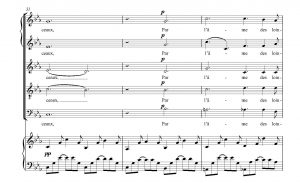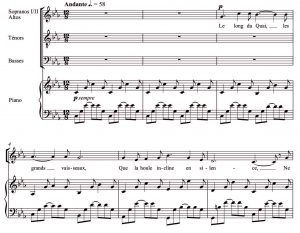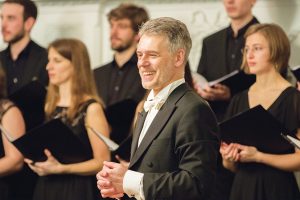Pieces for solo voice and piano arranged for choir and piano: homage or betrayal?
Denis Rouger, choral conductor, teacher, and composer
At a rehearsal back in the 2000s, the Paris-Sorbonne University Choir and I were working on a piece of French music with a style and feel that called to mind the famous mélodie by Duparc, L’invitation au voyage, a setting of a Baudelaire poem. I asked the choir members which of them knew it. Just two people out of 90 timidly raised their hand. With a sudden sense of urgency, I decided that, rather than have them listen to Duparc’s masterpiece, I would get them to sing it in an arrangement for choir, and so discover it “from the inside”.
Seeing how much the young musicians got out of this discovery, I decided to carry on adapting suitable mélodies (the total currently stands at more than 50), rejecting any that I felt might be distorted by the massed voices of the choir (mélodies requiring a great deal of transparency, such as Debussy’s Chansons de Bilitis, or certain Lieder too profoundly personal to be suitable for a choir).
Taking a great composer’s mélodie or Lied for solo voice and piano and arranging it for a choir singing in three, four, or five parts with piano accompaniment inevitably raises some questions:
-
- Do we have the right to modify masterpieces?
- Why should we do this? To what end?
- Is it possible to adapt a masterpiece in such a way as to keep any changes to the absolute minimum?
- What happens to the text, given that the language is an important part of a composition?
The answer to the first question might initially seem to be: no. But depending on how we answer the second question, we may be able to get around this outright ban in certain cases. As I see it, there are two simple reasons why we might want to arrange an original work for different forces:
-
- To introduce the piece to an audience who would not generally have access to it.
- To bring out the richness of a masterpiece by throwing a different light on it, i.e. showing off another side of the piece by expanding its soundworld. We would not be improving the piece, of course (!), but simply presenting it from a different perspective, just as a statue might be lit in very different ways or placed on different pedestals.
This kind of arrangement would require unwavering respect for the original score and its meaning. In order to answer “yes” to the third question, we would need to separate content and form, trying to preserve the work’s meaning despite changing its form. Finally, to answer the fourth question, the poem’s text and language are evidently key elements that, when considered alongside the several other factors at play, determine how faithful an arrangement is to the original work.
To help us understand the challenges of this kind of arrangement, and the difference that language makes, let’s compare a mélodie in French (e.g. Fauré’s Les berceaux, a setting of a text by Sully-Prudhomme1) and a German Lied (e.g. Hugo Wolf’s Verborgenheit, a setting of a magnificent text by Mörike2), both arranged for a choir singing in five parts. These two pieces are very different as far as form and inspiration are concerned, but many of the same factors come into play when we arrange them, although our approach to these factors might be different:
Prosody
-
- Respecting the text: sticking close to the prosody the author used for the original melody (no onomatopoeic “la la la”, “bam bam bam”, etc.).
- Respecting the meaning of the poem in each voice part: certain words might be deleted or repeated, but each phrase should still have its full meaning, so that the performers can always “say” their text.
Piano
Using the original part in full with no changes.
Harmony
This is a very tricky point. Absolute respect for the composer’s harmony is vital, but this harmony might be slightly extended for melodic reasons or because the polyphony “suggests” it. This would require as profound a knowledge of the composer’s musical language as possible in order to write as the composer themselves might have written (creating a sound that matches the “general impression” and that is strictly in the composer’s style).
Sometimes, when voice parts hold notes that the piano only briefly touches upon in arpeggios, dissonances are intensified and the existing harmony is nuanced, lending these moments a particular emotional colouring: in Fauré’s Les berceaux, for instance, the altos’ D held over the sopranos’ E flat makes bar 31 all the more dramatic.
“Orchestration”
-
- Varying use of the vocal possibilities afforded by between one and five voice parts depending on the context.
- Choosing a dense or airy polyphony depending on the sonorities of the harmony and the meaning of the text.
In Wolf’s Verborgenheit, the first phrase is tutti: the plea “Lass, o Welt!” (“Leave me, o world!”) is intensified when sung by multiple voices. The second, more intimate phrase, which evokes an almost imperceptible sadness and nostalgia, seems better suited to women’s voices alone, while the low chord in bar 20 and the dramatic crescendo that follows it are more powerful when sung polyphonically. After this great forte, the return of the first theme, now sung by the sopranos alone, seems more tender, more fragile and touching. The tenors’ fading B flat in bar 31 allows the tuttientrance to be gentle, evoking the universality of human longing.

The first phrase of Les berceaux is given to the upper voices alone: in Sully-Prudhomme’s poem, it is the women who stay on land with their young children, while the men go to sea, never knowing whether they will return. The grief that this phrase expresses is the women’s grief, and their unison voices convey not only their sadness, but also their solidarity.

Dynamics
Using different voice parts to contribute to dynamic effects (e.g. piano sung by two voice parts, forte by five). In bars 20 to 26 of Wolf’s Lied, as in bars 12 to 19 of Les berceaux, a long crescendo is intensified by capitalising on the dynamic possibilities of tutti compared to a single voice, lending the phrase a heightened sense of drama.
Sonorities
Using different voice parts to convey meaning (e.g. five parts singing pianissimo to evoke warmth and comfort, five parts singing in unison to emphasise the drama of a passage, two upper voice parts to convey transparency or lightness, or, as we have seen, to embody the words…).
The idea is not to “over-articulate” the words, but rather to let the original text blossom by bringing out its implicit content.
Choice of melodic lines and tessituras
Depending on the atmosphere of the poem and how it is set, always departing as little as possible from the composer’s musical language. There is naturally a link between the tessitura of each voice part and the tessitura of the original melody, but this melody can always be given to an internal voice, which would then be accompanied by a higher voice (this is not the case in our two examples).
Having the voice parts double the piano lines is practical, certainly, but the main reason to use this technique is to highlight certain words: in bars 7 and 8 of Verborgenheit, the alto part doubles the piano’s quavers only for the words “Herz” (heart) and “haben” (to have), discreetly emphasising them. In bars 15, 16, and 17, the alto part is syncopated, which heightens the drama of the moment by evoking tears or sighs.

In my opinion, these details work in the background to conjure up the atmosphere of the poem, but should remain discreet, almost invisible (or rather inaudible): the idea is not to “over-articulate” the words, but rather to let the original text blossom by bringing out its implicit content. These are subjective choices, of course, and a different arrangement could do something quite different with these factors. The main thing, in my opinion, is to use these elements not for their own sake (because a crescendo always makes an impact, for example), but to convey feelings that it may be impossible to convey through words alone. Taken together, the words of a poem make an impression on us that is far more than the sum of each word’s individual meaning—that’s the magic of language!
Giving due consideration to all these factors establishes a relatively strict framework, but one that leaves room for a creativity that is as exciting as it is surprising. This creativity encourages us to find our way to an act of writing that is close to composition, a free, personal, subjective act that is similar to performance in being based on absolute respect for the composer’s musical inspiration.
1Carus Verlag 9.243
2Carus Verlag 9.245
Denis Rouger is renowned for his rich choral sound and sensitive interpretations. He gained his first musical experiences as the son of a Parisian family of musicians and studied at the Conservatoire National Supérieur de Musique de Paris. He has been a lecturer and choral director at the University of Paris-Sorbonne for 20 years. For 10 years he has conducted the choir at Notre-Dame de Paris Cathedral and has been the Honorary Chapel Master of the Madeleine Church. As director of numerous ensembles he frequently travels to Germany, Italy, Holland, Canada, the United Arab Emirates and Switzerland (Lucerne Festival). He teaches masterclasses in Sweden, Bulgaria, France, Germany and Switzerland. Since 2011 he has been Professor of Choral Conducting at the Staatlichen Hochschule für Musik Stuttgart. The chamber choir he founded won first prize at the International Choir Competition in Mosbach in 2014. In 2016 he founded the figure humaine kammerchor, with whom he regularly gives concerts at well-known festivals and records CDs. In addition to his work as a choral director, he also composes and reworks French and German songs for choir. Email: Denis.rouger@figurehumaine.de
Translated by Katie Sykes, UK
Head photo: figure humaine Kammerchor © NB-Fotografie
